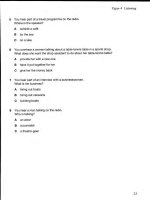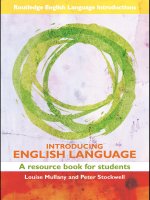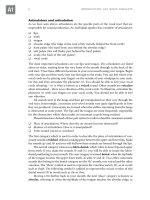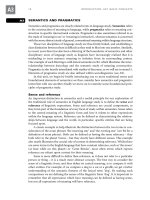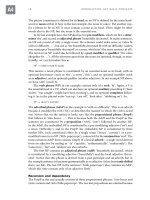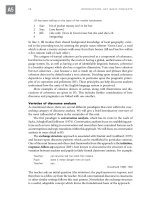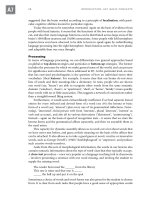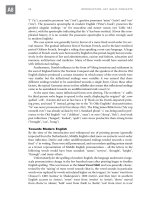Introdungcing English language part 3 ppt
Bạn đang xem bản rút gọn của tài liệu. Xem và tải ngay bản đầy đủ của tài liệu tại đây (199.75 KB, 6 trang )
ACKNOWLEDGEMENTS
The English Language is too wide a topic even for two authors, and this book has been
produced in the productive company of many friends and colleagues. In particular,
the School of English Studies at Nottingham University represents a world-class
collection of researchers and teachers whose expertise we have drawn on extensively.
We would like to extend our grateful thanks to Svenja Adolphs, Sarah Atkins, Kathy
Conklin, Robbie Dewa, Zoltán Dörnyei, Kevin Harvey, Dawn Knight, Christina
Lee, Mike McCarthy, John McKenny, John McRae, Richard Marsden, Roshni
Mooneeram, Nicola Royan, Norbert Schmitt, Violeta Sotirova, and Katie Wales. The
incomparable Ron Carter embodies the nearest we can imagine to an expert across
the entire field, and his advice throughout the whole writing process has been invalu-
able. Equally, we would also like to thank Sara Mills for perceptive and speedy advice,
and the numerous authors in the RELI series for useful comments and for reading
through drafts.
We are grateful to Phoebe Lin for her help with translations of the Hong Kong
advertising data. The Hong Kong street scene photographs were taken by Matt Green.
Our thanks to him for his permission to use these images. Thanks also to Chris Mullany
and Carol Rees for providing some excellent conversational data. We would also like
to thank Nadia Seemungal, Eloise Cook, Catherine Foley and Louisa Semlyen at
Routledge for perspicacity and patience.
Thanks and love to Joanna Gavins and Matt Green for creating space for another
project, and to Ada Stockwell and Edith Stockwell whose first adventures in language
appear in this book.
The authors and publishers would like to thank the following for permission to
reproduce copyright material:
Beverley Collins and Inger Mees, the editors Paul Foulkes and Gerry Docherty and
Arnold publishers for an extract from Urban Voices (2000);
The estate of John Sinclair for extracts from Trust the Text: Language, Corpus and
Discourse (Routledge, 2004);
Joan Cutting, the journal editors and Elsevier publishers for extracts from ‘The
speech acts of the in-group’, Journal of Pragmatics (2001);
Jenny Cheshire, the editors Leonie Cornips and Karen Corrigan and Benjamins
publishers for extracts from Syntax and Variation: Reconciling the Biological and
the Social (2005);
Guy Cook for extracts from The Discourse of Advertising (Routledge, 2001);
ACKNOWLEDGEMENTS xiii
Elinor Ochs and Bambi Schieffelin, the editors Paul Fletcher and Brian MacWhinney
and Blackwell publishers for extracts from The Handbook of Child Language
(1995);
John Field, the journal editors and Oxford University Press publishers for extracts from
‘Promoting perception: lexical segmentation in L2 listening’, ELT Journal (2003);
Jeremy Smith for extracts from An Historical Study of English: Function, Form and Change
(Routledge, 1996);
Lesley Milroy and Matthew Gordon and Blackwell publishers for extracts from
Sociolinguistics: Method and Interpretation (2003);
Andy Kirkpatrick and Cambridge University Press publishers for extracts from World
Englishes: Implications for International Communication and English (2007);
Paul Simpson for extracts from Language, Ideology and Point of View (Routledge, 1993);
Zoltán Dörnyei and Oxford University Press publishers for extracts from Research
Methods in Applied Linguistics (2007);
Bob Carter and Alison Sealey, and the editors Bob Carter and Caroline New for extracts
from Making Realism Work (Routledge, 2004);
The Bostin Group graphic novel company for an extract from Bostin Heroes: B Marks
the Spot.
Colleen McCants from the University of Nottingham’s Information Services Team for
the Politeness in Second Life article;
Carmen Llamas for the Survey of Regional English (SuRE) Sense Relation Network
methodology from ‘A new methodology: data elicitation for social and regional
language variation studies’ Leeds Working Papers in Linguistics and Phonetics
(1999) 7: 95–119.
SECTION A
INTRODUCTION: KEY
BASIC CONCEPTS
2 INTRODUCTION: KEY BASIC CONCEPTS
PHONETICS AND PHONOLOGY
To begin our study of the English language we will start off with a consideration of
exactly how human beings are able to communicate with one another using speech.
The most logical way to begin is by focusing on speech sounds. The study of the sounds
that we produce when we engage in spoken communication is called phonetics. In
contrast with other mammals, the human body contains a complex set of equipment,
commonly known as the organs of speech, which enables us to produce spoken
language. The power for all speech sounds emanates from the lungs, travels up the
windpipe, past the vocal cords and then into and out of the mouth or nose.
Individuals who conduct research on speech sounds are known as phoneticians.
Phoneticians investigate the production of speech in one of three ways: through audi-
tory phonetics, which refers to how speech sounds are perceived, through acoustic
phonetics, referring to how speech sounds are made up of physical properties, and
finally through articulatory phonetics, the study of how speech sounds are produced
by the organs of speech known as articulators. The units on sounds in this book (A1–D1)
fall under the third category, articulatory phonetics. This is the area of phonetics that
has the most applicability in an introduction to the English language and it is also the
most accessible area of investigation within phonetic science.
In order to be able to learn about articulatory phonetics as a foundational area
for English language study it is really important for you to test out speech sounds
practically yourself to get to grips with exactly how your own articulators work. Though
articulating individual speech sounds in isolation, without surrounding sounds to give
meaning to the noises that you make, may seem rather strange, as may articulating
seemingly random individual words in isolation, it is the most effective way to learn
about how your organs of speech work. If you are a little reticent to do this at first
you can always lock yourself away in a private room while reading the units on sounds!
Mastering exactly how your organs of speech work is an important step in enabling you
to recognise and describe all of the different sound features of the English language.
Another key area of study in the investigation of sounds is phonology, which is
a very closely related discipline to phonetics. Individuals who specialise in the study
of phonology are known as phonologists. As a general way of distinguishing between
the two disciplinary areas, phonology can be perceived as investigating sounds as an
abstract system, whereas phonetics focuses on the actual sounds as they are spoken
by specific individuals during particular speech events.
However, as you will find with many areas of the English language which we will
study in this book, the boundaries between disciplinary terms can often be fuzzy and
clear delineations between phonetics and phonology are frequently difficult to pin-
point. Overall, it is important to bear in mind that in order to produce a phonetic
analysis of speech in English you need to draw upon the phonological system of the
English language in order to fulfil this task successfully.
Within phonology, the term phoneme refers to a set of abstract units which together
form the sound system of a language. Contrasts in meaning are produced through
directly contrasting phonemes. For example, if we compare /p/ with /t/ as in pip and
tip then a different meaning is created by the contrast. Word pairings where there is
only one sound change between them, as in this example, are known as minimal pairs.
A1
PHONETICS AND PHONOLOGY 3
Phonemes of the English language, or any other language for that matter, can only
exist as abstract entities. They can never be literally produced by speakers.
The written system of the English language, or its orthography as it is technically
termed, does not correspond directly with how words are articulated in speech. In
order to make a permanent, written record of speech sounds, known as a transcript,
there is a need to use a separate writing system, especially devised for this purpose.
This system is known as the International Phonetic Alphabet, or the IPA. It provides
a much more accurate version of the sounds of the English language as well as other
language systems too.
A distinction can be made between the production of phonemic transcripts
and phonetic transcripts. The former do not demonstrate the actual articulation and
instead highlight the contrasts from one phoneme to another. Phonemes are transcribed
in slanted brackets, such as /p/ or /t/, whereas actual phonetic realisations, exactly how
the sounds are articulated by speakers, are represented by square brackets such as [p]
or [t].
There are variants that exist within individual phonemes when these are realised
phonetically by different speakers, which are termed allophones. The allophones of
a phoneme are concrete entities produced by speakers and can thus be analysed pho-
netically and recorded in a phonetic transcript. To illustrate, the phoneme /t/ in the
word butter can be realised as [t] or by the glottal stop [m]. The term ‘glottal stop’ is
derived from the glottis, the space that exists between vocal cords. It refers to occasions
when the vocal cords close and block the air from the lungs – it is a very common
speech feature in many regional varieties of English (see D1 for further discussion).
The phoneme /l/ can be realised either by the allophone known as light l (some-
times termed clear l), when /l/ is produced at the front of the mouth as in the begin-
ning of words such as lip, or by the allophone known as dark l, the name given to /l/
when it is produced at the back of the mouth, as in the end of a word, such as pool.
However, realisations of /l/ will vary depending upon the speaker. For instance, if uttered
by a speaker with a Scottish accent, the dark ‘l’ quality is articulated at the beginning
and end of words, so lip and pool would be articulated with the same dark ‘l’ sound.
In contrast with phonemic transcripts, phonetic transcripts will indicate these subtle
differences in speakers’ articulation of allophones. Phonetic transcription contains
additional marks known as diacritics, which enable the finer details of articulation to
be recorded. For example, if we consider the allophones of the phoneme /l/ highlighted
above, if a speaker produces dark l this is more accurately represented with addition
of the following diacritical mark: [/] as opposed to light ‘l’, represented by [l] with-
out the diacritical mark.
Say the words pool and lip out loud to yourself concentrating in particular on your
realisation of the phoneme /l/. Decide whether your articulations can be represented
as having a ‘light’ or ‘dark’ quality. Also say the word butter out loud to yourself and
decide if you articulate the phoneme /t/ as [t] or as a glottal stop [m].
Glottal stops can also be utilised by speakers when pronouncing the consonants
/p/ and /k/ as well as /t/. Listen out for glottal stop usage in the everyday speech you
hear around you, including on the radio, television and via the internet. Which
speakers tend to use the glottal stop feature? Which speakers do not?
The IPA symbols will be further illustrated in B1.
